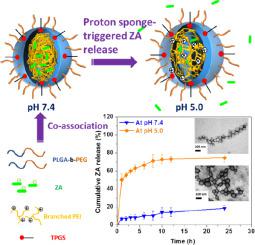Biomaterials Advances ( IF 5.5 ) Pub Date : 2020-07-07 , DOI: 10.1016/j.msec.2020.111277 Min-Cong Xiao,Ya-Hsuan Chou,Yu-Ning Hung,Shang-Hsiu Hu,Wen-Hsuan Chiang

|
Zoledronic acid (ZA), a third-generation nitrogen-heterocycle-containing bisphosphonate, has been frequently used as an anti-resorptive agent to treat cancer-involved hypercalcemia and painful bone metastases. In order to expand the clinical applications of ZA toward the extraskeletal tumor treatment, it is essential to develop the functionalized nanocarriers capable of carrying high ZA payload and achieving intracellular triggered ZA release. In this end, the ZA-encapsulated hybrid polymeric nanoparticles were fabricated in this work by co-association of the amphiphilic diblock copolymer poly(lactic-co-glycolic acid)-b-poly(ethylene glycol) (PLGA-b-PEG), tocopheryl polyethylene glycol succinate (TPGS) segments and ionic complexes composed of ZA molecules and branched poly(ethylenimine) (PEI) segments. Notably, the ionic pairings of PEI segments with ZA molecules not only assisted encapsulation of ZA into the PLGA-rich core of hybrid nanoparticles but also reduced adhesion of ZA on the surfaces of hydrophobic cores, thus largely increasing ZA loading capacity. The dynamic light scattering (DLS) and transmission electron microscopy (TEM) characterization revealed that the ZA/PEI-loaded nanoparticles had a well-dispersed spherical shape. Moreover, compared to short PEI1.8k (1.8 kDa) segments, the longer PEI10k (10 kDa) segments formed more robust complexes with ZA molecules, thus prominently promoting ZA loading content of hybrid nanoparticles and their colloidal stability. Interestingly, with the suspension pH being reduced from 7.4 to 5.0, the considerable disruption of ZA/PEI ionic complexes owing to the acid-activated protonation of ZA molecules and the developed proton sponge-like effect inside the nanoparticle matrix upon the protonated PEI segments facilitated the rapid release of ZA molecules from drug-loaded hybrid nanoparticles. The results of in vitro cellular uptake and cytotoxicity studies showed that the ZA/PEI-loaded hybrid nanoparticles were internalized by MCF-7 cells upon energy-dependent endocytosis and displayed a superior cytotoxic effect to free ZA. This work demonstrates that the unique ZA/PEI-loaded hybrid polymeric nanoparticles display great promise for anticancer applications.
中文翻译:

具有高唑来膦酸有效载荷和质子海绵触发的快速药物释放的杂化聚合物纳米颗粒,用于抗癌应用。
唑来膦酸(ZA)是第三代含氮杂环的双膦酸酯,经常被用作治疗癌症引起的高钙血症和痛苦的骨转移的抗再吸收剂。为了将ZA的临床应用扩展到骨骼外肿瘤治疗,必须开发能够携带高ZA有效载荷并实现细胞内触发的ZA释放的功能化纳米载体。在为此,ZA-包封复合高分子纳米颗粒在这项工作中由制造共两亲性嵌段共聚物的聚(乳酸-的-association共-乙醇酸-β-聚乙二醇(PLGA-b-PEG),生育酚基聚乙二醇琥珀酸酯(TPGS)片段和由ZA分子和支链聚(乙烯亚胺)(PEI)片段组成的离子配合物。值得注意的是,PEI段与ZA分子的离子配对不仅有助于将ZA封装到杂化纳米颗粒的富含PLGA的核中,而且还减少了ZA在疏水核表面上的附着力,从而大大提高了ZA的负载能力。动态光散射(DLS)和透射电子显微镜(TEM)表征表明,负载ZA / PEI的纳米颗粒具有良好分散的球形。此外,与较短的PEI 1.8k(1.8 kDa)段相比,较长的PEI 10k(10 kDa)片段与ZA分子形成了更坚固的复合物,从而显着提高了杂化纳米颗粒的ZA负载量及其胶体稳定性。有趣的是,随着悬浮液的pH从7.4降低到5.0,ZA / PEI离子络合物的显着破坏是由于ZA分子的酸激活质子化以及纳米颗粒基质内部对质子化的PEI片段产生的质子海绵样效应所致。 ZA分子从载药的杂化纳米颗粒中快速释放。体外细胞摄取和细胞毒性研究的结果表明,ZA-PEI杂合纳米颗粒在能量依赖性内吞作用下被MCF-7细胞内化,并显示出优于游离ZA的优异细胞毒性作用。











































 京公网安备 11010802027423号
京公网安备 11010802027423号